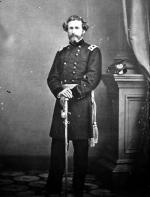![header=[Marker Text] body=[In the Musical Fund Hall here in June 1856, John C. Fremont was nominated for President of the U.S. He lost the election to James Buchanan. Formed in 1854 the Republican Party opposed the extension of slavery; Lincoln was its first nominee elected President (1860). ] sign](http://explorepahistory.com/kora/files/1/10/1-A-121-139-ExplorePAHistory-a0a4o8-a_450.gif)
Mouse over for marker text
Name:
First Republican National Convention
Region:
Philadelphia and its Countryside/Lehigh Valley
County:
Philadelphia
Marker Location:
808 Locust Street, Philadelphia
Dedication Date:
June 17, 2000
Behind the Marker
"Our town is again alive with the bustle and excitement of a grand convention," reported the Philadelphia Bulletin after the opening of the Republican convention on June 17, 1856. "The hotels are crowded to the highest flight with politicians of many shades."
Grassroots political parties and national nominating conventions were still only about twenty-five years old in 1856. They were exciting spectacles in an age when more than 3 out of 4 eligible voters participated in presidential elections.
The year 1854 is the traditional date of origin for the Republican Party, but the process of organizing it really continued until 1856. In those years, the heart of any political machine beat on the state level. The organization of state Republican parties, which began in places like Ripon, Wisconsin, in 1854, continued through the 1856 presidential election.
Republicans wanted a fresh face for their first presidential contest. They chose forty-three-year-old John Frémont, nicknamed "The Pathfinder," because he had been a celebrated western explorer. He had served briefly in the U.S. Senate from California but otherwise had no government experience. Better-known New York senator William Seward was the first choice of most Republican delegates, but his advisors convinced him that the new party had no chance and that his smartest move would be to wait for 1860. That year the Republicans met in Chicago and Seward ended up finishing second to Abraham Lincoln.
Lincoln was in the running for the vice-presidential nomination at Philadelphia. He came in second to William Dayton of New Jersey, who then served as Frémont's running mate.
Built in 1824 as a meeting place for the Musical Fund Society, and afterwards used by many local organizations and institutions, the Hall is part of the National Register of Historic Places. Threatened with destruction in the 1970s, the site is now an apartment building.
Grassroots political parties and national nominating conventions were still only about twenty-five years old in 1856. They were exciting spectacles in an age when more than 3 out of 4 eligible voters participated in presidential elections.
The year 1854 is the traditional date of origin for the Republican Party, but the process of organizing it really continued until 1856. In those years, the heart of any political machine beat on the state level. The organization of state Republican parties, which began in places like Ripon, Wisconsin, in 1854, continued through the 1856 presidential election.
Republicans wanted a fresh face for their first presidential contest. They chose forty-three-year-old John Frémont, nicknamed "The Pathfinder," because he had been a celebrated western explorer. He had served briefly in the U.S. Senate from California but otherwise had no government experience. Better-known New York senator William Seward was the first choice of most Republican delegates, but his advisors convinced him that the new party had no chance and that his smartest move would be to wait for 1860. That year the Republicans met in Chicago and Seward ended up finishing second to Abraham Lincoln.
Lincoln was in the running for the vice-presidential nomination at Philadelphia. He came in second to William Dayton of New Jersey, who then served as Frémont's running mate.
Built in 1824 as a meeting place for the Musical Fund Society, and afterwards used by many local organizations and institutions, the Hall is part of the National Register of Historic Places. Threatened with destruction in the 1970s, the site is now an apartment building.






